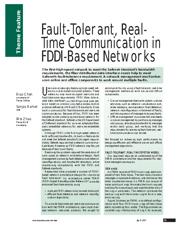Fault-tolerant real-time communication in FDDI-based networks
Biao Chen, S. Kamat, Wei Zhao
Proceedings 16th IEEE Real-Time Systems Symposium
U sers are increasingly deploying high-speed networks in distributed computer systems. These networks may have stringent real-time and fault-tolerance requirements. FDDI (fiber distributed data interface) 1 is a 100-Mbps local area network based on a token ring media access control protocol defined by ANSI and OSI standards. It has built-in provisions for fault-tolerance and real-time communications. Because of this, FDDI has been adopted as the underlying backbone network for the Safenet
more »
... rd. Safenet is the US Department of Defense's standard for survival adaptable fiber optic embedded networks for real-time embedded systems. Although FDDI is the first high-speed network with sufficient bandwidth, its built-in features do not meet the Safenet standard's stringent requirements. Safenet requires that a network survive multiple faults. However, an FDDI network may fail just because of two trunk faults. Resolving this problem required the resolution of such issues as network architecture design, fault management (including fault detection and network reconfiguration), and bandwidth allocation, while maintaining compatibility with the FDDI and Safenet standards. Researchers have proposed a number of FDDIbased network architecture designs for improving fault tolerance. 2 An architecture called FBRN (FDDI-Based Reconfigurable Network) 3,4 provides enhanced fault tolerance by using • multiple FDDI networks to connect hosts and • efficient fault detection and network reconfiguration algorithms. To provide fault-tolerant real-time communication with the FBRN architecture, users must manage network resources properly. We sought to accomplish this by using a fault-tolerant, real-time management mechanism with online and offline components. • Online management deals with system runtime activities, such as network initialization and, when necessary, reinitialization; fault detection; network reconfiguration in the event of faults; and the migration of messages to bypass faults. • Offline management minimizes the overheads in online management by partitioning messages into groups, allocating bandwidth to messages within each group, and verifying that the requirements for achieving fault-tolerant, realtime communication can be met. We focused on achieving high performance by designing efficient and effective online and offline management algorithms. FAULT-TOLERANT, REAL-TIME SYSTEM MODEL Our approach requires an understanding of the FBRN architecture and the requirements for realtime message transmission. FBRN model An FBRN consists of FDDI trunk rings, each composed of two fiber loops. The two loops transmit messages in opposite directions, one clockwise, the other counterclockwise. An FBRN can consist of many such trunk rings. Normally, the trunk ring uses one loop for transmission and uses the other only if the ring in use breaks. The network combines the backup ring with the broken ring to form a new, working ring. Figure 1a shows an FBRN in its default configuration with four FDDI trunk rings (of two loops each) connecting four nodes. The figure shows an unrolled ring-the top loop of ring 1, for example, The first high-speed network to meet the Safenet standard's bandwidth requirements, the fiber distributed data interface needs help to meet Safenet's fault-tolerance requirement. A network management mechanism uses online and offline components to work around multiple faults.
doi:10.1109/real.1995.495204
dblp:conf/rtss/ChenKZ95
fatcat:fkyb4jz4gzfe7dysl3bba66jrq

